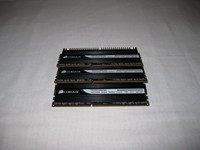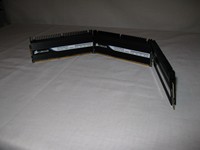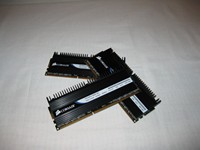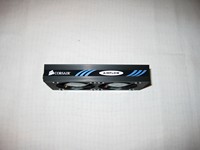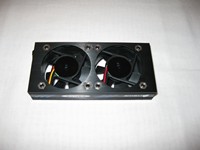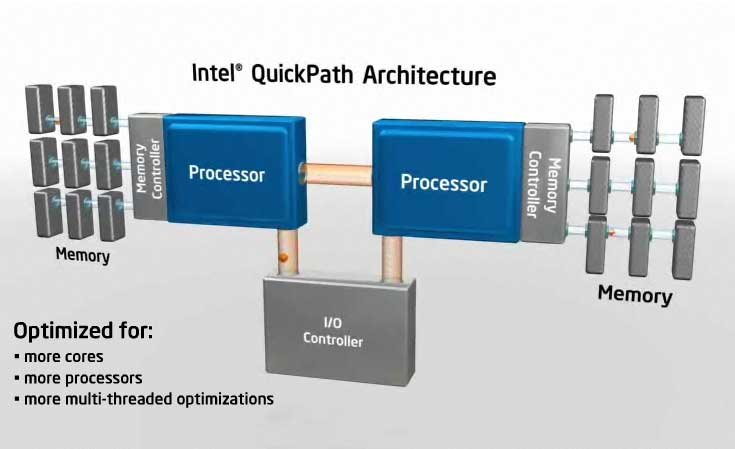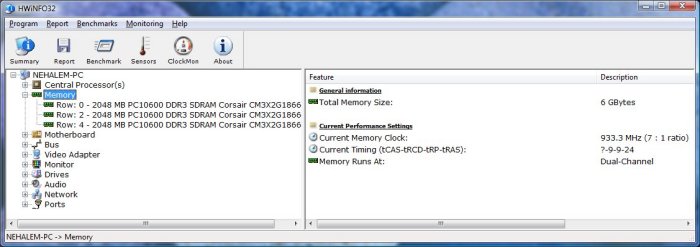Corsair one on the biggest names in memory has moved into triple channel memory for Core i7 in a big way. They’ve fielded Dominators in speeds of 1600, 1866 and 2000 MHz.
INTRODUCTION
Corsair is one of the most predominate memory manufacturers in the industry. They have moved into the Triple Channel memory market designed for Core i7 and its low voltage DDR3 needs (1.65v is the accepted voltage limit on Core i7). Not only have they moved into that market segment, they’ve brought their top of the line enthusiast memory, the Dominator series, into the picture. The Dominator series has been a favorite among enthusiasts for quite a while now. Featuring tight timings and the distinctive Dominator black look and sporting the Dual-path Heat Xchange (DHX) heat sinks, they’re an imposing sight.
Several factors come into play where Dominators are concerned. First and foremost, blazing speed, then they just look really cool, and the name says it best, Dominators. Other factors include the excellent technical support, Lifetime Warranty, and the Corsair name. When you’re driving Corsair RAM, you know you’re driving some of the best!

About Corsair
Products to Meet the Demands of Performance Computing
Corsair has been a leader in the design and manufacture of high-speed modules since 1994. Our focus has always been on supporting the special demands of mission-critical servers and high-end workstations, as well as the performance demands of extreme gamers. While maintaining this core focus, in recent years, we’ve also brought our expertise, technology leadership and legendary quality and reliability to memory and other technology products for the more mainstream consumer.
Memory That Meets The Toughest Demands
As a pioneer in high-speed module design, Corsair is a trusted supplier to many computer manufacturers. In high-density memory solutions, Corsair has always been one of the first suppliers to achieve advanced qualifications on Intel, Tyan and SuperMicro server platforms. We also work closely with other major server platform manufacturers to release product that is 100% compatible with their latest server products.
What Sets Corsair Apart?
With more high-speed experience than anyone in the industry, we know the importance of design features like tightly-controlled trace lengths, controlled impedances, clock trace design, unbroken power and ground planes, and selectively plated gold. Corsair Memory has developed an industry-wide reputation for quality, compatibility and performance.
Performance Memory For Enthusiasts
Our flagship memory products are the DOMINATOR™ line of performance memory, which is designed for the unique demands of the serious enthusiast community. Featuring patent-pending Dual-path Heat Exchange (DHX) technology, the DOMINATOR family maximizes on performance, minimizes on heat, all the while running with heighten reliability and stability. The DOMINATOR line has set world performance records and won numerous awards. Corsair’s mainstream performance memory solutions are the XMS family. The XMS family includes XMS2 DHX, featuring innovative DHX technology now in the mainstream; XMS Xpert, the first modules with real-time display of parametric data; XMS Pro Series, gaming memory with real-time activity LEDs; and XMS2, high-performance DDR2 modules with black heat spreaders. The XMS Family also includes DDR1 solutions in XMS, available in either black or platinum heat spreaders.
Our Value Select memory brings our quality and compatibility standards to cost-effective products for today’s most popular desktops and laptops. Value Select is available in DDR1 and DDR2.
We also offer a large range of ultra-reliable server memory for mission-critical servers and high-performance clusters.
Flash Memory, Liquid Cooling and Power Supplies
Corsair has expanded beyond memory modules to offer performance liquid cooling units and blocks under our Corsair Nautilus brand and power supplies under our HX Series brand.
In addition, we offer a line of specialty Flash memory. From our ultra-rugged Flash Survivor™ family to the multi-award winning durable Flash Voyager™ family, Corsair has quickly established itself as an industry leader for USB drives.
SPECIFICATIONS
- 6144 Megabytes of DDR3 memory
- Three 2GB modules
- 100% tested at 1866MHz in Gigabyte EX58-UD5 motherboards
- Lifetime warranty
- DHX technology provides maximum cooling
Testing Specs Features
- Each three module set is tested at 1866MHz
- Packaged together immediately following system test
- Tested together at 1866MHz, Vdimm = 1.65V, at latency settings of 9-9-9-24 on X58-based motherboards.
- SP D programmed at: XMP 9-9-9-24 values at 1866MHz JEDEC standard 9-9-9-24 values at 1333MHz.
Pictures & Impressions

We wanted to lead out with the specifications label on the Dominator kit to get that out of the way. You can see it’s rated to run at 9-9-9-24 at 1.65v and it’s a 6 GB kit with 3 sticks of 2 GB each.
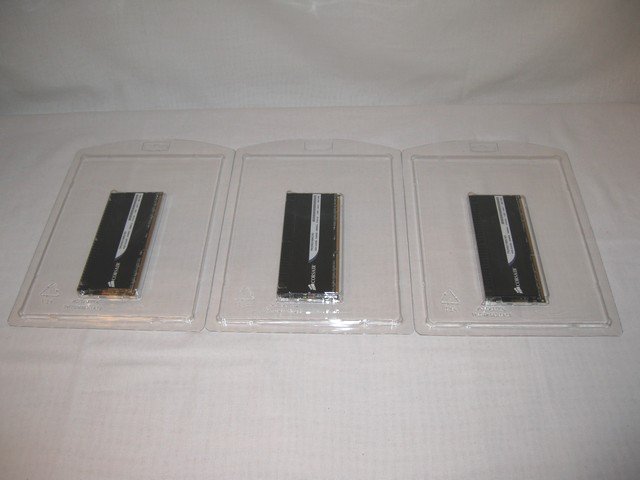
This is an early release kit so this isn’t the retail packaging you’ll be seeing if you order a kit. The interim packaging was sufficient to protect the Dominator kit on it’s journey.
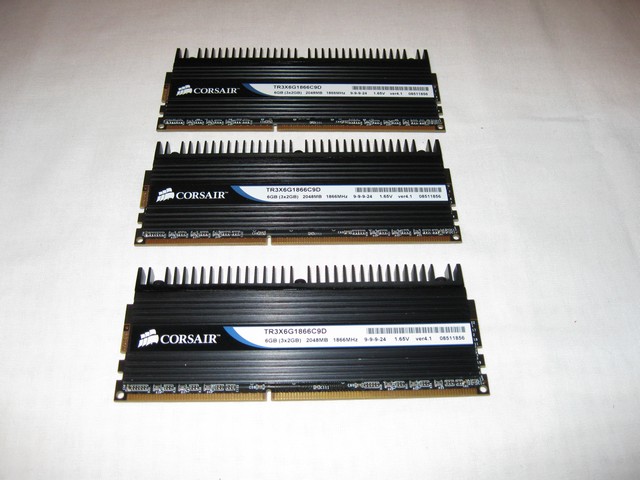
Laid out, the Dominator has that Dominator Signature look, black and imposing. There’s just something about the Dominator kit that’s hard to define, it looks good and manages to project a presence that says, “Here I am, I’m Dominator, you’re going to love me.” The IHX (Integrated Heat Xchanger) is very effective at removing heat from the modules.
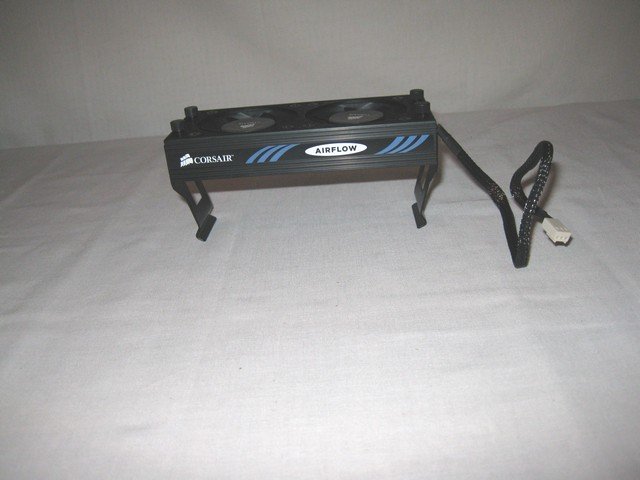
The IHX is even more effective when used in conjunction with the optional fan kit that helps keep the RAM nice and cool. You won’t have to worry about heat when you’re overclocking this kit if you have opted for the sweet fan kit.
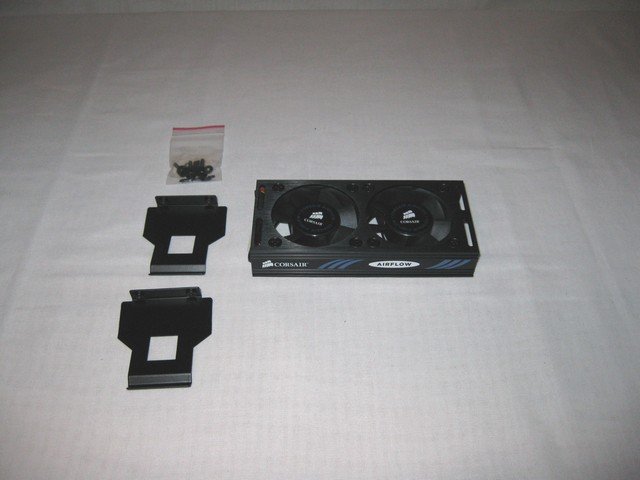
There’s a little assembly required for the fan kit but it was an easy assembly and only took a couple of minutes.
We’ve been trying something a little different to see how readers respond to it, and we’re including that in this review. We like to provide a lot of pictures of sweet looking products, but we’re experimenting with a thumbnail gallery. Please feel free to give us some feedback on the thumbnail gallery in the thread in our forums to help us decide if it’s something we want to continue, adjust or expand upon.
Any of the images below may be clicked on to open up a larger version.
Thumbnail Gallery
THE OLD WAY
Pulled from the Corsair site
Intel’s newest architecture, known as Nehalem (nee-HAY-lem), is an interesting and mysterious beast. There are some of the most significant changes in years inside this bad boy, so let’s get straight to the point.
The biggest and most important change for us to talk about today is the memory controller. The memory controller, much like its name implies, is the interface between the memory and the processor. Typically located on the “North Bridge” chip on the motherboard, the memory controller communicated to the processor through the “Front Side Bus” or FSB.
THE OLD WAY – A SYSTEM WITH A FRONT-SIDE BUS

In this image, the FSB is the connection between the processor(s) and the memory controller. Notice the memory controller is the interface between the CPU and the memory, as well as the interface between the CPU and the I/O controller, which would control your hard drives, USB ports, etc.
In the past, overclocking was usually achieved by tweaking this FSB. For example, on a Core 2 Duo system where the processor’s multiplier is locked, we might have seen the FSB at 800 or 1066. Typically this was twice what the actual host frequency was, so a processor would have a multiplier based on the actual host clock.
Example: The Intel Core 2 Extreme QX9770 runs at 3.2 GHz, and claims a “1600 MHz” FSB. This is a “Quad-pumped” FSB and the host clock is truly running at 400 MHz, still extremely fast. So the multiplier of this processor is 8.
Host clock * Multiplier = Clock Speed
400 MHz * 8 = 3200 MHz, or 3.2 GHz.
THE NEW WAY
But “Nehalem” changes everything. Much like AMD did with their initial launch of the Athlon64 years ago, Intel has finally moved the memory controller onto the processor itself.
Here’s how the new way works.
THE NEW WAY – QUICKPATH INTERCONNECT
The FSB has been removed completely – the memory controller and processor now have very little delay. This allows much lower latency and provides a significant increase in computing performance.
Testing & Methodology
To test the Corsair Dominator TC DDR3 1866 6GB kit we did a fresh load of Vista 64 on our Core i7 965 Extreme test system and ran our normal battery of tests on it. We ran the tests a total of three times and the average of the three test runs is reported here. All patches and updates were applied prior to testing and no background tasks that might interfere with testing were running.

We’re using our Core i7 965 Extreme test rig for the Corsair Dominator Triple Channel 1866 MHz kit. We kept the settings to a multiplier overclock until we overclocked the RAM, then we dropped the multiplier and increased the FSB until we had maxed the RAM kit out.
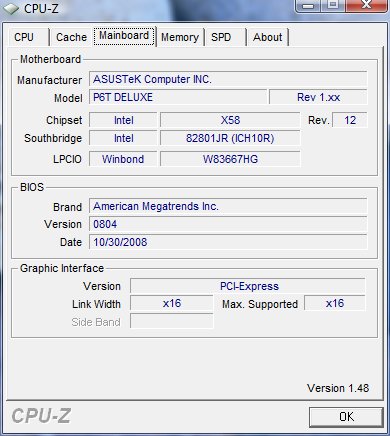
We’re still using the Asus P6T which we’ve used with the same settings on all our RAM testing on this board.
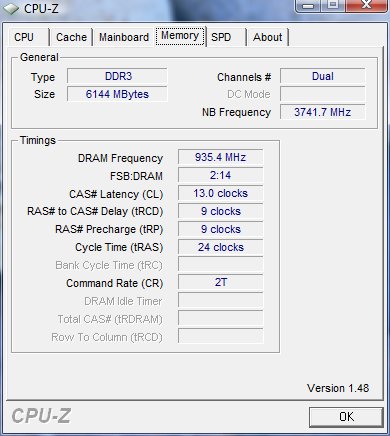
CPU-Z is reporting the kit at 13-9-9-24 but we checked against several other utilities and it’s just CPU-Z reporting the speed wrong. It seems to happen with a variety of high sped DDR3 Triple Channel kits. BIOS says the memory is running at 9-9-9-24 and HWInfo32 reports the timing as ?-9-9-24 so were not sure if it’s a translation problem from the X58 chipset or Software. If we find out anything new we’ll update you.
If you’d like to see how we confirmed programs reading high speed DDR3 Triple Channel wrong you can click on the picture of HWInfo32 for a larger image and you’ll see the kit is listed as ?-9-9-24. Unless someone has developed a RAM timing of “?” several different utilities are reading multiple kits of RAM we tested wrong.
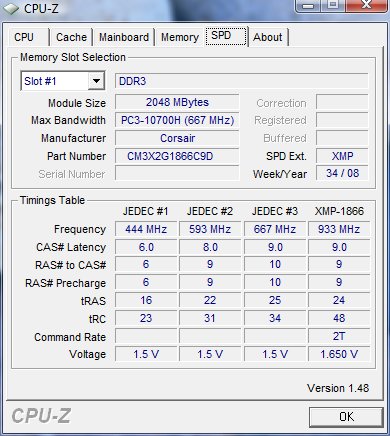
We ran the kit at 9-9-9-24 at every speed except 1066 where we tightened the timings down to 6-6-6-24. The RAM ran good at every speed with default settings and ran well at 1066 with 6-6-6-24. No voltage increases or additional tweaking was needed.
Test Rig
| Test Rig “Quadzilla” |
|
| Case Type | Top Deck Testing Station |
| CPU | Intel Core I7 965 Extreme (3.74 GHz 1.2975 Vcore) |
| Motherboard | Asus P6T Deluxe (SLI and CrossFire on Demand) |
| Ram | Corsair Dominator DDR3 1866 6 GB (9-9-9-24 1.65v) Corsair Dominator DDR3 1600 6 GB (8-8-8-24 1.65v) G.Skill DDR 3 1600 6GB Kit (9-9-9-24 1.5v) Kingston HyperX DDR 3 2000 3GB Kit (9,9,9,24 1.65v) Kingston HyperX DDR3 1600 6 GB (8-8-8-20 1.65v) |
| CPU Cooler | Thermalright Ultra 120 RT (Dual 120mm Fans) |
| Hard Drives | 2 WD VelociRaptors in RAID 0 |
| Optical | Sony DVD R/W |
| GPU | EVGA GTX-280s in SLI Drivers 180.47 |
| Case Fans | 120mm Fan cooling the mosfet CPU area |
| Docking Stations | None |
| Testing PSU | Thermaltake Toughpower 1K |
| Legacy | None |
| Mouse | Razer Lachesis |
| Keyboard | Razer Lycosa |
| Gaming Ear Buds |
Razer Moray |
| Speakers | None |
| Any Attempt Copy This System Configuration May Lead to Bankruptcy | |
Test Suite
|
Synthetic Benchmarks & Games |
|
SANDRA XII Professional |
|
Everest Ultimate Edition v.4.50.1330 |
|
SuperPi Mod 1.5XS |
|
WinRar v.3.71 Compression Benchmark |
SISOFT SANDRA 2009 SP1
“SiSoftware Sandra (the System ANalyser, Diagnostic and Reporting Assistant) is an information & diagnostic utility. It should provide most of the information (including undocumented) you need to know about your hardware, software and other devices whether hardware or software. It works along the lines of other Windows utilities, however it tries to go beyond them and show you more of what’s really going on. Giving the user the ability to draw comparisons at both a high and low-level. You can get information about the CPU, chipset, video adapter, ports, printers, sound card, memory, network, Windows internals, AGP, PCI, PCI-X, PCIe (PCI Express), database, USB, USB2, 1394/Firewire, etc.”
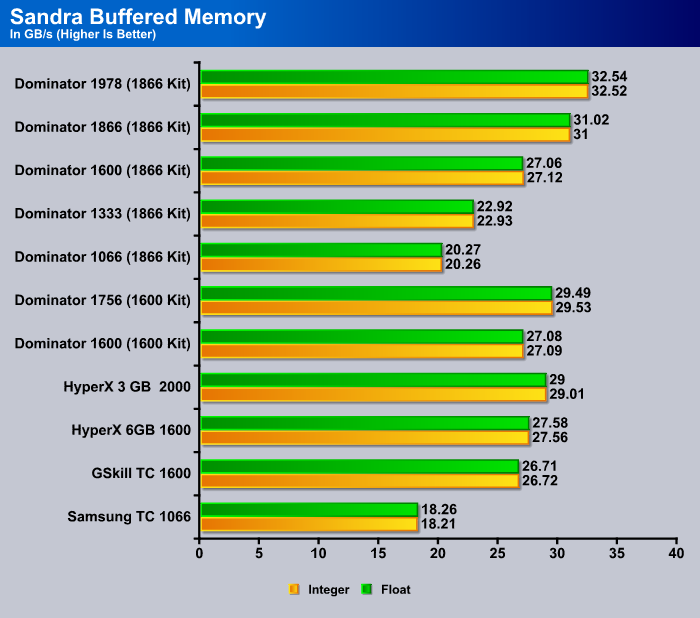
The Corsair Dominator kit is a 6GB kit so it has that advantage over the Kingston 2GHz kit and the advantage shows. The Kingston 1600 Kit runs faster at 1600 but when we clock the Corsair Dominator kit up to 1866 and beyond, which is out of reach of the Kingston kit, the Dominator pulls out in the lead. That’s to be expected. The Kingston kit is rated to run at 1600 and the Dominator kit is rated to run at 1866 and we managed a nice overclock to 1978. At 1866 MHz we get 31 GB/s and the 112 MHz overclock helped to boost that to a whopping 32.5 GB/s, which is to date the fastest kit we’ve tested.
SuperPi
SuperPi is the “Gold Standard” for many when it comes to judging system performance. We ran 1 and 2 MB calculations, again running each test three times and reporting the average of the results.
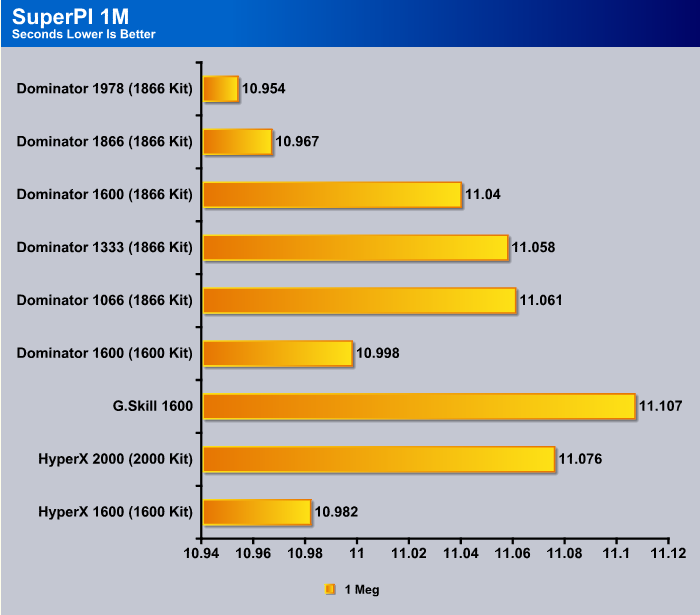
It’s fairly easy to see that at the Dominator’s top two speeds of 1866 and 1978 that it’s the fastest kit we’ve run so far. The closest kit to that blazing speed is the Kingston 1600 kit. We thought the Kingston 2GHz kit would have done better, but it’s hard to compare 3GB kits to 6GB kits because of the performance differences in the sizes of the two kits.
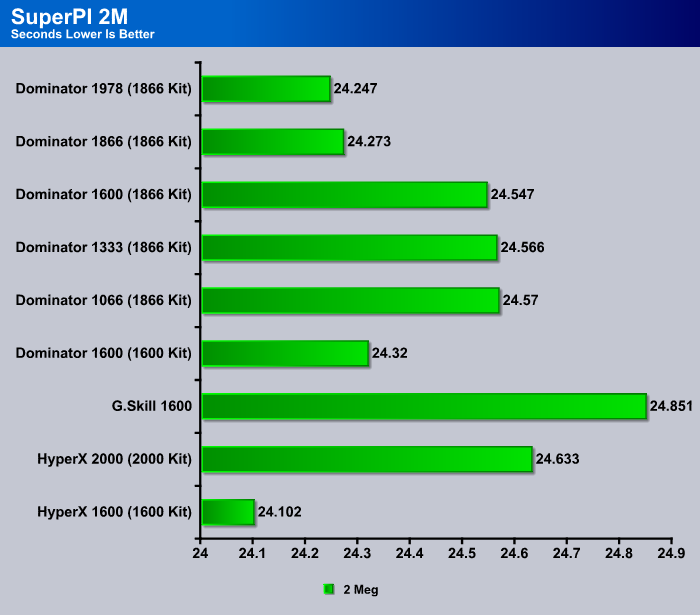
When we got to the 2 MB SuperPi test the Kingston 1600 6GB kit kicked up its heels and jumped out in front, but only by .15 of a single second. Differences like that can be easily attributed to background tasks that can’t be disabled. With a little tweaking on the Dominator kit, we’re pretty sure you could decrease that run time by a decent margin.
WinRar v. 3.71
This module in WinRar generates random data, which contains specially introduced redundancy, increasing the load to both the processor and memory. Data is the passed through RAR compression and decompression algorithms, and the output of the decompression algorithm is compared to the source data. If any differences are found, WinRAR then reports “Errors found – Yes” in the command window. WinRAR displays a size of processed data and compression speed, current and resulting, in kilobytes per second.
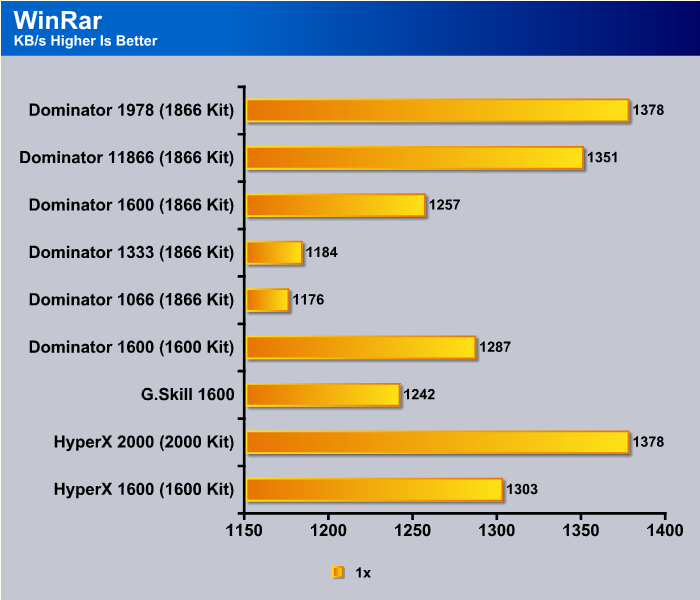
The Dominator 1866 kit did as well as the HyperX kit that’s running a little bit faster, both coming in at 1378 KB/s. Given that the Dominator is giving up a 22MHz edge to the 2 GHz kit, that’s pretty decent.
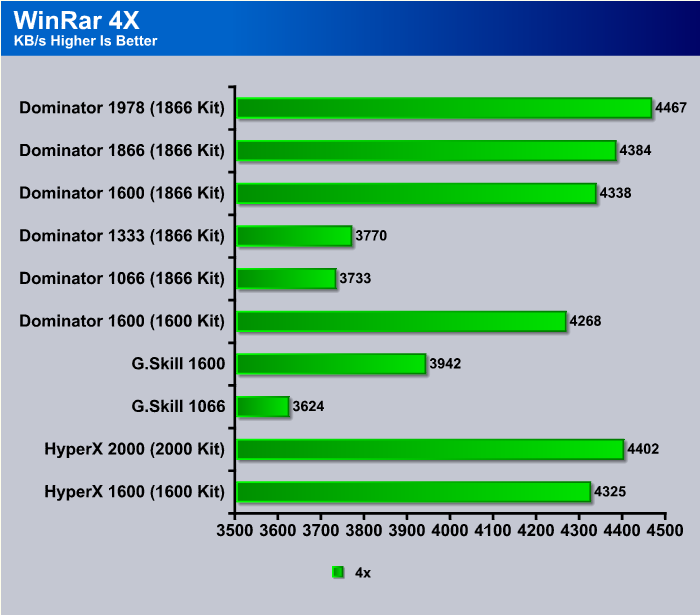
When we got to the WinRar multithreaded test the Dominator kit jumped out to a decent lead over all the kits we tested. With a nice FSB overclock you’d get a little better performance from the kit. We’ve been using a multiplier overclock for most testing on the Core i7 965. When we overclocked to 1978, we did drop the multiplier a couple of notches and put a little FSB speed to the kit, but not like most people with locked multiplier Core i7’s will. With a higher FSB, performance should rise even farther.
EVEREST ULTIMATE
“EVEREST Ultimate Edition is an industry leading system diagnostics and benchmarking solution for enthusiasts PC users, based on the award-winning EVEREST Technology. During system optimizations and tweaking it provides essential system and overclock information, advanced hardware monitoring and diagnostics capabilities to check the effects of the applied settings. CPU, FPU and memory benchmarks are available to measure the actual system performance and compare it to previous states or other systems. Furthermore, complete software, operating system and security information makes EVEREST Ultimate Edition a comprehensive system diagnostics tool that offers a total of 100 pages of information about your PC.”
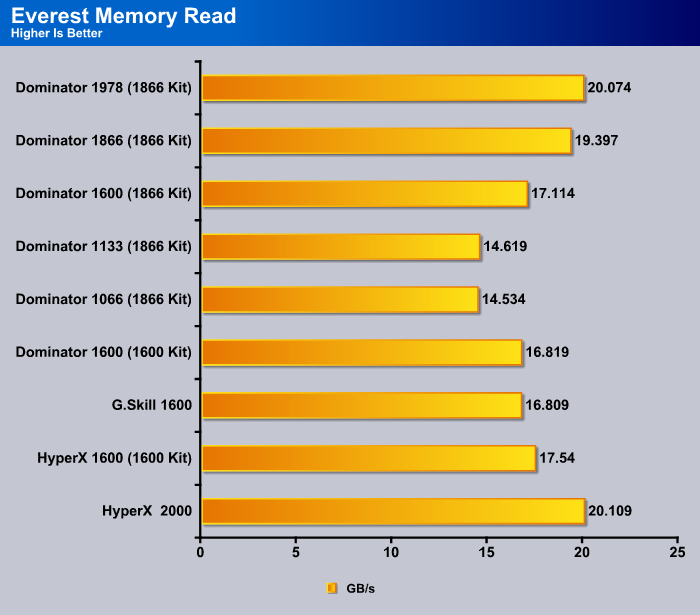
The integrated memory controller and Intel XMP profiles in Core i7 have improved memory bandwidth so much it’s hard to not be impressed by the quantum leap in bandwidth. Even Everest, which is scores lower than Sandra because of testing differences, has us up over 20GB/s. You gotta love that.
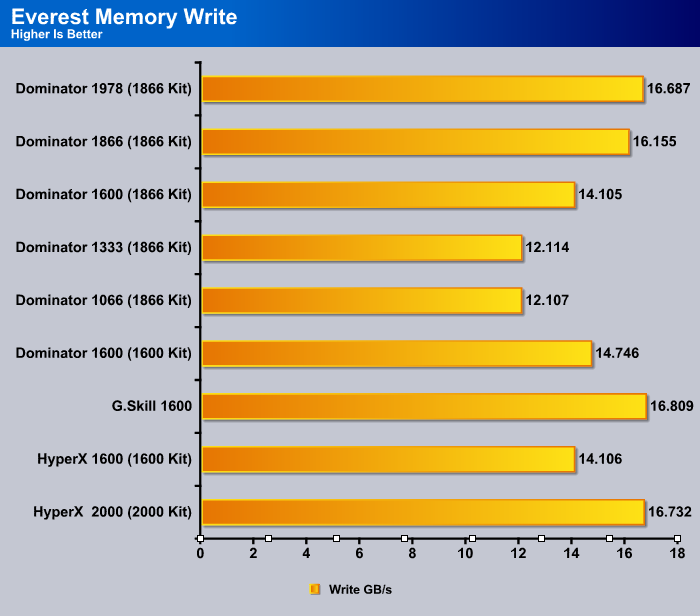
The Corsair Dominator comes in just behind the 3GB Kit of Kingston HyperX running at 2GHz and the G.Skill 1600 kit. Once again, differences this small can be no more than anomalies in testing, but the Dominator (and other kits) did amazingly well.
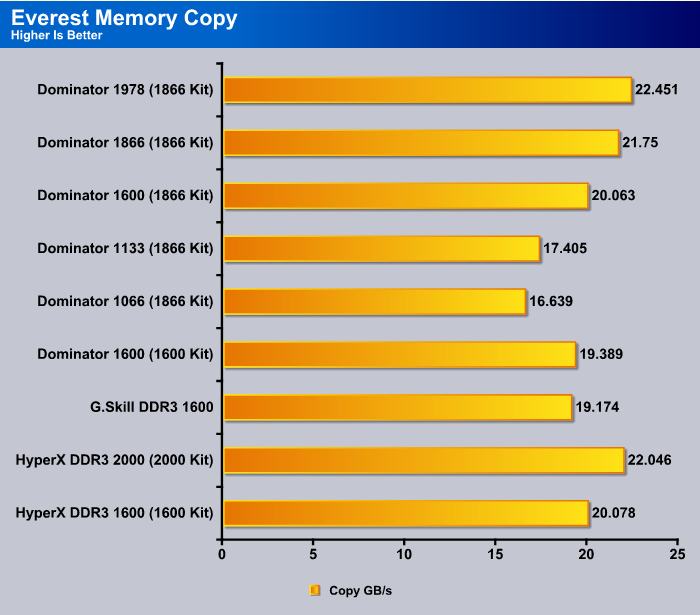
In the Everest Memory Copy test the Dominator 1866 kit took the lead again. This time by enough that we can rule out background tasks as a possible cause. We can tell that when we get more time we’re going to have to play with this kit a little more to get the most out of it.
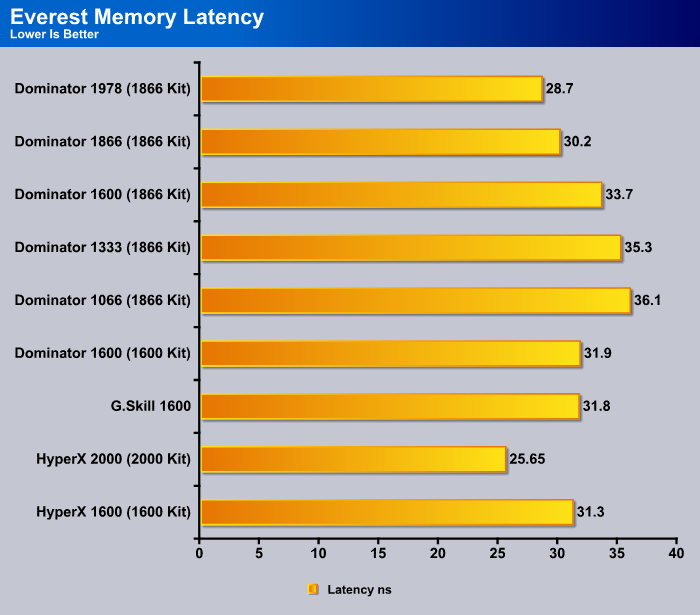
The Latency on the Dominator kit is more than respectable. Running at its default speed of 1866 MHz we have a 30.2 ns latency and when we overclocked it got even better, dropping to 28.7 ns. With latencies like that, applications are going to respond quickly, and the system will have a snappy feel to it.
CONCLUSION
We’ve been testing a lot of Triple channel RAM kits lately as Core i7 gains more acceptance and a wider user base. We’ve seen a lot of kits, done more than a lot of testing, and the Corsair Dominator triple channel kit is one of the best, if not the best, we’ve tested thus far. Unlike DDR3 on the 775 platform, on the X58 platform, it’s almost always been plug and play compatible. Set the XMP profile and you’re running at the rated speed and timings with no additional tweaking needed. The Dominator kit was entirely plug and play and for a kit of 1866 MHz RAM, that’s just amazing. The ability to run at that speed with minimal effort is a really nice feature and goes a long way with us.
Overclocking was a snap and involved no more than dropping the multiplier on the Core i7 965 and upping the bus speed until we maxed out the RAM, staying within the 1.65v Intel recommended voltage maximum.

Again, CPU-Z is reading the timings slightly wrong. We checked multiple times and in the BIOS it’s reading 9-9-9-24 and the RAM ran great at 1978 with 1.65v and timings in the BIOS set to 9-9-9-24. We were able to tighten the timings a little but your mileage will vary on that depending on your system and overclocking skills. We prefer to test at what we know the kit will run and at the maximum overclock with the rated timings to show you what you can realistically expect. If you get any better than that, it’s all gravy.
The Corsair Dominator 1866 MHz kit produced the highest bandwidth of any kit we’ve tested thus far, topping 32GB/s easily. With some tweaking, we’re betting it will go even higher. With the Corsair name behind it, the quality we’ve come to expect from Corsair and the Dominator series, if you’re looking to get every ounce of performance from your Core i7 rig, Dominator is one of the best choices you can make. We’re extremely pleased with the kit.
We are trying out a new addition to our scoring system to provide additional feedback beyond a flat score. Please note that the final score isn’t an aggregate average of the new rating system.
- Performance 10
- Value 8
- Quality 10
- Warranty 10
- Features 10
- Innovation 10
Pros:
+ Ease Of Setup
+ Overclocked Well at Stock Volts
+ Ran Nice And Cool With The Included Fan Kit
+ IHX (Integrated Heat Exchanger) Provides Some Nice Eye Candy
+ Corsair Quality
+ Lifetime Warranty
+ Did We Mention Blazing Speed
Cons:
– Triple Channel Memory Is A Little Expensive
– May Have Spoiled Us For Life
The Corsair Dominator 1866 MHz Triple Channel kit produced the most bandwidth of any kit we’ve tested so far, the performance gains are sweet, and show not only in Synthetic benchmarks but make a real difference in the way the rig runs. It’s unparalleled speed, ease of setup, and performance increase earn it a:
Final Score: 9.5 out of 10 and the Bjorn3D Golden Bear Award.
 Bjorn3D.com Bjorn3d.com – Satisfying Your Daily Tech Cravings Since 1996
Bjorn3D.com Bjorn3d.com – Satisfying Your Daily Tech Cravings Since 1996



